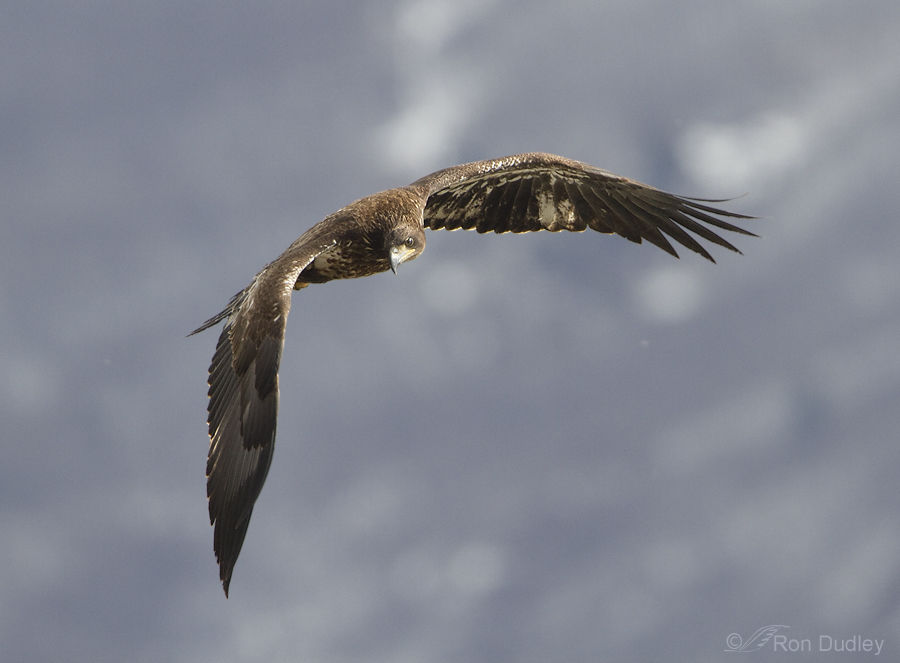Tag: immature
A Guide To Aging Bald Eagles
As we go into prime “eagle watching” season here in northern Utah I thought it might be timely to present a guide that would be helpful in aging Bald Eagles as they progress through the 5-6 year process of becoming adults. Many of these younger birds are mistakenly identified as Golden Eagles by the general public. Eagles that have not reached the adult stage are referred to as immature, juveniles or sub-adults. Plumage stages are highly variable, depending on molt sequence, age and timing so other factors like iris and beak color are also taken into account when estimating age. Eyes gradually change from dark brown to yellow while the beak goes from blackish-gray to yellow. 1/4000, f/8, ISO 500, 500 f/4, not baited, set up or called in The adult Bald Eagle is unmistakable with its distinctive bright white head and tail contrasting with the dark brown body and wings. 1/200, f/6.3, ISO 800, 500 f/4, 1.4 tc, not baited, set up or called in But juveniles present very differently than adults, especially in the early stages of development. This very young bird is barely fledged and was still hanging around its nest in sw Montana. Notice that the plumage is dark brown throughout, though they may have some white or pale mottling at this stage – especially on the underparts. Both eye and beak are very dark. 1/2000, f/6.3, ISO 500, 500 f/4, 1.4 tc, not baited, set up or called in This is a first year bird during winter. 1/800, f/8, ISO 500, 500 f/4, natural light,…
Landing Red-tailed Hawk
I haven’t often succeeded in photographing a landing raptor. When they take off they usually don’t come back and when they do it’s often difficult to maintain focus on them as they land because of close backgrounds. However, this immature Red-tailed Hawk gave me just such an opportunity a couple of days ago. 1/2000, f 7.1, ISO 500, 500 f/4 It was hunting from a huge rock outcropping and looking down over the valley in the background of this image. I spent quite a while with this bird but it was side lit and I wasn’t very optimistic about getting a decent take-off shot because I expected it to spot potential prey in the valley below and take off away from me, giving me butt shots only. 1/1600, f 7.1, ISO 500, 500 f/4 Which is exactly what happened. However, I saw where the bird landed far below in the valley, missed the prey and took off again so I wondered if I could be lucky enough for it to return to the same perch. I wasn’t particularly optimistic because I was so close to the rock (you’ll notice from my techs that I had even removed my tc). The problem was that as soon as the hawk took off from that distant perch it disappeared behind the same massive rock outcropping on the side of the mountain that had been its perch and if it did return I wouldn’t know it until the very last split second, as it flared up to land on the rock from behind and below it. So I prefocussed on the likely…
Juvenile Marsh Wren
I normally have difficulty getting close enough to Marsh Wrens for them to be large enough in the frame to show good detail. They’re very small, incredibly flitty and they inhabit busy backgrounds – all challenges for the photographer. Last year I had some success with adults but juveniles have always eluded me. 1/1600, f/6.3, ISO 500, 500 f/4, 1.4 tc But yesterday at Bear River Migratory Bird Refuge I found this cooperative juvenile in good light and the background reeds were far enough away from the bird to soften nicely. And I didn’t even get shadows from the reeds falling on the bird which is unusual for me. I love these feisty, raucous little birds and they have unbelievable energy. They scurry from perch to perch and sing almost continually, day and night during breeding season, in their bid for reproductive success. It makes me tired just to contemplate such a frenzied existence. Think I’ll take a nap… Ron


